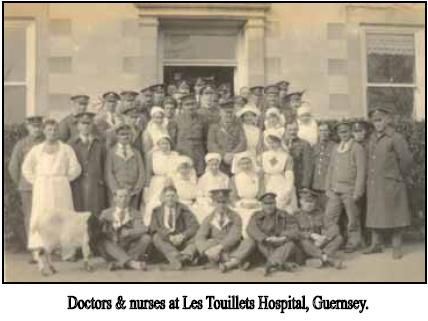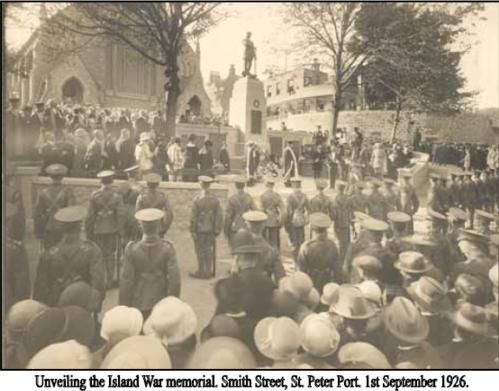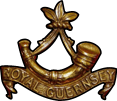The Royal Guernsey Light Infantry - WW1
The 1914 – 18 war and the death of a regiment
In 1914, as Europe went to war, the Royal Guernsey Militia,
which at that time consisted of two infantry regiments
and an artillery regiment, was mobilised to replace
the regular army garrison which was withdrawn to reinforce
the British Expeditionary Force in France and Flanders.

Recruiting for The 16th Irish Division
St. Peter Port Gsy. 1915
Militiamen could not be sent overseas but the States
of Guernsey decided to offer a contingent of trained
men to the British Government. This offer was taken
up gratefully and in the end two full strength infantry
companies and a machine gun section were sent to join
the 16th Irish Division which was forming in Ireland
as part of Kitchener’s all volunteer army. The
companies were attached to 6 Royal Irish Regiment and
7 Royal Irish Fusiliers; the machine gun company went
to 6 RIR.

In addition a Divisional Ammunition Column was formed
from the Royal Guernsey Artillery and sent to 9th Scottish
Division. The 16th Division took part in the fighting
on the Somme in 1916 and the Guernsey Companies suffered
heavy casualties.
They were eventually disbanded in early 1918. In the
meantime the States decided that they would send a full
infantry battalion to the British army, probably because
they felt that the island should be seen to be doing
its bit.

As a result at the end of 1916 the Militia was suspended
for the duration of the war, conscription was introduced
and the Royal Guernsey Light Infantry was raised as
part of
the British army.
Most of the initial officers and men were former members
of the Militia but later drafts were not.

Before they left the Island a big parade was held
on L’Ancresse Common when medals were presented
to soldiers who had served with the volunteer companies
but were now with the RGLI after convalescing from wounds
received in action. They also received a set of camp
colours sewn by ladies of Guernsey.

After completing its basic training in Guernsey the
battalion left the Island for England on 1st June 1917
for advanced training at Bourne Park camp near Canterbury.
After advanced infantry training the battalion sailed
for France on 26th September.
On their arrival they were attached to 29th Infantry
Division which was commanded by a Guernseyman, Major-General
Beauvoir de Lisle and posted to 86th Brigade.

The Division was made up of regular army battalions
and had recently served with considerable distinction
in Gallipoli. However by the time the RGLI joined many
of the old regular soldiers had become casualties and
it is likely that the morale and motivation of the Guernsey
troops was higher than that of the battalions around
them. By the time the RGLI arrived in France to join
29th Division the Western Front had been in place for
some time.
. 
A continuous line of trenches ran 475 miles from the
North Sea to Switzerland. A trench, in theory at least,
was a ditch some 10 to 12 feet in depth with a raised
fire step along the side facing the enemy. The sides
would be revetted with timber to hold back the earth
and there might be duckboards to keep the soldiers’
feet out of the mud - if they were lucky. Dug outs were
cut back from the side of the trench in which off duty
men could shelter and perhaps sleep. The trenches zigzagged
to prevent the blast from an explosion travelling along
them.

There were usually three lines of trenches - the main
or front line, the support and further back the reserve
lines. Soldiers would be rotated through these systems
so that in theory at any rate they could get some rest
while in support or reserve although much time in reserve
would be spent repairing trenches or carrying supplies
into the line.
After three years of continuous fighting the trenches were pestilential places where
the dead of both sides lay unburied and rats and vermin
flourished. Many areas were flooded
fighting the trenches were pestilential places where
the dead of both sides lay unburied and rats and vermin
flourished. Many areas were flooded
and men could and did drown in mud filled shell holes.
An incautious move could draw the attention of a sniper
and even if things were quiet there was a constant stream
of casualties from artillery and mortar fire as well
as from
sickness and disease.
The original idea behind the Battle of Cambrai was a
kind of large scale tank raid on the German rear areas
with the idea of destroying enemy personnel, guns, supplies
and most of all morale, but not to capture or hold ground.
The tank was in its infancy and nobody was
quite sure how best to use it and what effect it would
have on the enemy.
In the end the plan was much expanded into a major operation
with the objective of pushing the Germans back a considerable
distance. The attack was successful beyond the planners’
wildest dreams and almost all the objectives were achieved
with minimal - by Western Front standard - casualties.
The RGLI, for instance, took their objective, far behind
the German front line with only one officer and two
soldiers killed and 25 wounded.

But retribution was not far away. German doctrine set,
and indeed still sets, great store by early counter
attack on lost positions and ten days after the British
attack the Germans struck back. The Guernseys were ordered
to hold a little village called Les Rues Vertes on the
outskirts of Masnieres on the River Escaut and hold
it they did. Twice they were pushed out of the ruins
by weight of numbers, twice they retook the village
at the point of the bayonet, fighting with great tenacity
which aroused the admiration of all who watched them.
Sadly however such valour does not come cheap and by
the end of the fighting 40% of the battalion’s
total strength of 1311 all ranks were dead, missing
or wounded.
It was the end of a generation in Guernsey and the
Island watched, numbed almost into disbelief, as the
casualty returns grew and grew until there was hardly
a family in the Island, grand or humble, that had not
lost a loved one.
Document. Le Poidevin’s Account
“The enemy were now coming across and surrendering
in larger numbers. They were badly wounded most of them
and had the very fear of hell depicted on their faces.
The surprise had been a success and had caught Fritz
quite unprepared. We were now on the move towards our
objective and covered many miles of ground, the Tanks
were ahead and we passed many dug-outs & huts where
Fritz had made himself snug since Aug. 1914. We met
with little resistance apart from snipers who were very
active from Nine Wood. My left section put 2 snipers
out of mess.

Although they had put their hands up and were “Kamerads”.
But they shot some of
my platoon. After some stiff fighting we took our Objective,
Nines Wood and made
use of the shell holes for consolidating our position.
I had the luck of capturing 5 Huns here, who gave us
some valuable information.”
Sgt. W.J. Le Poidevin RGLI
Document. Le Poidevin’s Account
“At one time 3 of us were surrounded with Germans.
We gave a good account of
ourselves till I got the effects of a bomb and was wounded
in the leg and thighs. I managed to crawl to a farmhouse
and applied first aid to my leg. After that I was done
and could not move. It was very fortunate that I was
found by one of our men & help secured to take me
back to the dressing station. It was decided to evacuate
Messinières. The RFA volunteered to come from
Marcoing & take away the wounded in Messinières.
While I was being carried along the Canal Bank my stretcher
was heavily shelled, and one shell dropped just behind
the stretcher killing two and wounding a third. I was
Providentially preserved as apart from being thrown
out I was unhurt. I managed to crawl about a 100yards
and stumbled across the Headquarters of the Inniskilling
Fus.”
Sgt. W.J. Le Poidevin RGLI
Document Chapman’s Account
Extract from a letter to Lt. Hutchinson from Lt. E.A.
Chapman.
“I feel I must write & tell you what a fine
company you had & what fine men they were. The NCOs
& men were bricks every one of them & as brave
as lions. They really did excellent work & by jove
they had something to put up with…….. They
all stuck to me like good ‘uns. Of course I was
at a great disadvantage not knowing the men, but in
the short time I had them I got to love them……
Never have I seen such pluck & endurance in any
men. The way they went over the top & went over
3 miles to their objective when they were fagged out
was a marvel & they dug in & reconsolidated
like good ‘uns & didn’t care a rap for
Shells or bullets or Huns……They were good
in rest, & when we went into the line again, &
got heavily shelled they showed utter contempt to the
danger.
They had some very unpleasant & risky jobs &
worked so well. The officers too were great. Poor L..?
was killed as you know in our first counter attack.
He was such a good chap. “Bottles” &
Morgan did excellent work. Poor Morgan has died of his
wounds.
“Bottles” I cannot get news of. He was exceptionally
good with his men & showed
himself a very fine officer. Plucky & full of grit
& he had some very ticklish jobs. I am sure you
would have been the proudest man in the Army if you
had seen your Officers & men at work.”
After Cambrai there was a real danger that the RGLI’s
service battalion would be disbanded and the men posted
to other regiments. There were no more Guernsey lads
to fill the ranks and after much pleading by the Lt.
Governor large numbers of English soldiers were drafted
to the Guernseys to fill the gaps left by the slaughter
at Les Rues Vertes. Most of them came from the 3rd Battalion
the North Staffordshire Regiment.
During the early part of 1918 the RGLI was in the line
at Passchendaele, perhaps the most unpleasant and unhealthy
part of the Western Front where the awful conditions
resulted in almost as many casualties as did German
shell fire. Meanwhile the Germans were able to move
huge numbers of troops from the Eastern Front to the
Western Front following the collapse of Imperial Russia
and were planning a final attack in the west with the
aim of winning the war, or at least forcing the Allies
to the conference table. The main weight of this attack
fell on the old battlefield of the Somme, but a subsidiary
attack took place in the Lys area of northern France.
The full weight of the attack fell on a Portuguese Division,
new to the line, which broke and ran. The 29th Division,
including the Guernsey troops, were rushed into the
line tostem the advance.
In the action which followed the vast majority of the
battalion became casualties. On 11th April Lt. Col.
T.L. de Havilland took into action 20 officers and 483
men. By 14th April he was reduced to just three officers
and 55 other ranks. But the German attack had run out
of steam and the last offensive was over. The battalion
had played its part in stemming the flow but at a terrible
cost.
steam and the last offensive was over. The battalion
had played its part in stemming the flow but at a terrible
cost.
The wounded were sometimes
the lucky ones. “To cop a Blighty one” was
the dream of the men in the trenches. The reality could
be horrifyingly different. The most common injury sustained
in the trenches was a head wound from artillery shrapnel.
A steel helmet lessened the danger, but did not remove
it. Poison gas was most feared. Men died slowly and
painfully from its effects. Throughout the 1920s and
1930s ex-servicemen continued to die from the effects
of gassing in the war. Injuries inflicted to the mind
from unbelievable horrors seen and experienced, had
to be lived with. From the front line Casualty Clearing
Stations, the wounded were passed back to base hospitals
and in more serious cases, back to England - “Blighty”.

Some RGLI casualties were repatriated to Guernsey. They
were nursed by women and girls who very quickly had
demonstrated a toughness that belied their genteel backgrounds.
Nurses and doctors fought
death and disease without
antibiotics, penicillin, plastic surgery, skingrafts
or blood transfusions. All of these came later, as a
result of the research born of necessity during the
war.
Lt. Chapman’s Letter
No. 2 Red Cross Hospital
Public Schools Wards
A.P.O. 2 BEF Rouen
France
“ As you have probably heard I had my right leg
amputated as it was smashed by a shell & my left
leg is broken at the shin. It was the work of two separate
shells. Sgt. Le Poidevin came to my rescue & got
me down a cellar at the risk of his life & some
one else. I think it was my batman. I am pleased to
say I am doing well now & gaining strength every
day. My pulse & temperature are good & my appetite
is wonderful. I can eat anything, & drink anything,
& I feel remarkably fit now. I get rather bad nights
& lots of pain occasionally. The dressing of my
legs which takes place every two days is a painful procedure.
I am going to Blighty after Xmas.”
Lt. E.A.Chapman of the Buffs was in command of B Coy
during Cambrai.
The Survivors
After Lys a few men who had been separated during the
battle straggled back to the battalion but there was
no question that the RGLI would be able to go back into
the line in the foreseeable future.

A few days later the battalion was ordered to leave
29th Division and report to Ecuires where they took
over as guard troops on Field Marshal Douglas Haig’s
headquarters at Montreuil. There they licked their wounds
and received a number of drafts of new soldiers from
the depot in Guernsey. But the RGLI’s war was
over. In May 1919 the battalion returned to Guernsey


The Cost.
The RGLI left behind them in France 327 graves bearing
their cap badge. Many many more Guernseymen suffered
grievous wounds of body and mind while yet others had
suffered years of captivity in Germany. The war had
been won, but at a terrible cost which was felt in every
home in the Island. When the call for men came in 1939
the States remembered 1917 and 1918 and refused to send
the Militia to war.
The Total Number of men who served in the RGLI was
3549 Of those the number recruited in Guernsey was 2430
The remainder were transferred from England.

Of the 3549 men of the RGLI, 2280 served in France with
the 1st (Service) Battalion.
The following casualties were sustained.
Killed in Action or Missing, presumed dead. 230 - Died
of Wounds 67
Died of Sickness 30 - Total 327
Wounded 667- Prisoners of War 255
The following honours were awarded to the RGLI
Officers 1 Companion of the Order of St. Michael &
St. George
4 Military Crosses - 1 Member of the Royal Victorian
Order
Men 3 Distinguished Conduct Medals - 7 Military Medals
1 Medaille Militaire - 1 Croix de Guerre
2 Officers and 2 men were mentioned in Dispatches.
Here dead we lie because we did not choose
To live and shame the land from which we sprung.
Life, to be sure, is nothing much to lose;
But young men think it is, and we were young.
A.E. Housman 1859-1936

Men Killed in World War One
Note that this is an incomplete list
CHARLES JOHN BARNES - Corporal 3156
6th Bn., Royal Irish Regiment who died on Saturday,
9th September 1916. Age 28.
Son of William H. and Martha R. Barnes, of 3 Manor Cottages,
Colborne Rd., Guernsey.
THIEPVAL MEMORIAL, Somme, France Pier and Face 3 A
JAMES BATISTE - Private 3456
"D" Coy. 6th Bn., Royal Irish Regiment who
died on Sunday, 3rd September 1916. Age 31.
Son of James and Amelia Batiste, of Les Marais, Vale,
Guernsey; husband of Olive Blanche Batiste, of 2, Orangeville,
Bouet, Guernsey.
THIEPVAL MEMORIAL, Somme, France Pier and Face 3 A
C De G BLONDEL - Corporal 773
1st Bn., Royal Guernsey Light Inf who died on Monday,
9th December 1918.
BERLIN SOUTH-WESTERN CEMETERY, Brandenburg, Germany
II. D. 8.
GEORGE WILSON - Lance Corporal 2324
2nd Bn., Royal Guernsey Light Inf who died on Thursday,
7th November 1918. Age 43.
Son of John and Jane Wilson; husband of Christiana Wilson.
Born at Bingley, Yorks.
FORT GEORGE MILITARY CEMETERY, Channel Islands, United
Kingdom G. 223
Fort George is a fortress on the east coast of Guernsey
in the southern vicinity of St. Peter Port.
|

